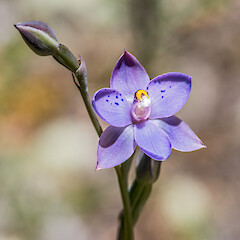Thelymitra nervosa
Common name
spotted sun orchid, sun orchid
Synonyms
Thelymitra decora Cheeseman
Family
Orchidaceae
Flora category
Vascular – Native
Endemic taxon
Yes
Endemic genus
No
Endemic family
No
Structural class
Orchids
NVS code
The National Vegetation Survey (NVS) Databank is a physical archive and electronic databank containing records of over 94,000 vegetation survey plots - including data from over 19,000 permanent plots. NVS maintains a standard set of species code abbreviations that correspond to standard scientific plant names from the Ngä Tipu o Aotearoa - New Zealand Plants database.
THENER
Chromosome number
2n = 54
Current conservation status
The conservation status of all known New Zealand vascular plant taxa at the rank of species and below were reassessed in 2017 using the New Zealand Threat Classification System (NZTCS) – more information about this can be found on the NZTCS website. This report includes a statistical summary and brief notes on changes since 2012 and replaces all previous NZTCS lists for vascular plants.
Please note, threat classifications are often suggested by authors when publications fall between NZTCS assessment periods – an interim threat classification status has not been assessed by the NZTCS panel.
- Conservation status of New Zealand indigenous vascular plants, 2017 . 2018. Peter J. de Lange, Jeremy R. Rolfe, John W. Barkla, Shannel P. Courtney, Paul D. Champion, Leon R. Perrie, Sarah M. Beadel, Kerry A. Ford, Ilse Breitwieser, Ines Schönberger, Rowan Hindmarsh-Walls, Peter B. Heenan and Kate Ladley. Department of Conservation. Source: NZTCS and licensed by DOC for reuse under the Creative Commons Attribution 4.0 International licence.
2017 | Not Threatened
Previous conservation statuses
2012 | Not Threatened
2009 | Not Threatened
2004 | Not Threatened
Distribution
Endemic. New Zealand: North Island, South Island, Stewart Island/Rakiura, Chatham Islands.
Habitat
Lowland to alpine (up to 1400 m a.s.l.). Mostly montane in northern part of range, extending to lowland area in the southern South Island, Stewart Island/Rakiura and Chatham Islands. In well lighted places within tall forest, scrub, tussock grassland or on more or less bare lava fields (Tongariro National Park).
Detailed description
Terrestrial, tuberous, glabrous, spring to summer-green perennial herb, growing solitary or in colonies of 4–10 plants arising through vegetative extension. Plant at flowering up to 600 mm tall. Leaf broad, channelled and deeply keeled, (60)–90–(260) × (8)–12–(20) mm. Bracts 1–2–(3), foliaceous, closely-sheathing, fleshy, of similar colour to stem and leaf. Inflorescence a (1)–10-flowered raceme. Flowers up to 18 mm diameter, spreading, rarely widely spreading, segments dark to pale blue, mauve, pink or white usually with darker blue spotted petals, sometimes without spots. Sepals and petals alike, ovate-oblong, subacute more or less concave (cupped) resulting in a rounded appearance to the flower. Labellum slightly spathulate. Column erect, 3–6 mm tall, usually pale pink grading to dark purple near post-anther lobe; post-anther lobe extending well above anther-tip, initially dark purple and tuberculate above middle, margin yellow, narrowly hippocrepiform, somewhat membranous with a finely denticulate apex, weakly cucullate; column-arms terete to plano-convex in cross section; cilia copious, somewhat coarse, arising from sides, back and top of arm and mostly standing higher than post-anther lobe. Anther not thickened or incurved.
Manaaki Whenua Online Interactive Key
Similar taxa
Easily distinguished from other New Zealand Thelymitra by the rounded and cupped flower segments; spotted (not striped) petals; more or less terete (in cross-section) column arms furnished with copious white cilia; horse-shoe shaped, tuberculate and apically yellow post-anther lobe.
Flowering
October–February
Flower colours
Blue, Violet/Purple
Fruiting
November–April
Propagation technique
Very easily grown in a sunny, well drained site. Although easily cultivated, like all orchids it should not be removed from the wild.
Etymology
thelymitra: Woman’s hat
nervosa: With conspicuous veins
Where To Buy
Not commercially available
Attribution
Description adapted from Moore and Edgar (1970).
References and further reading
Moore LB, Edgar E. 1970. Flora of New Zealand, Volume II. Indigenous Tracheophyta: Monocotyledones except Gramineae. Government Printer, Wellington, NZ. 354 p.
Rolfe JR, de Lange PJ. 2010. Illustrated guide to New Zealand sun orchids, Thelymitra (Orchidaceae). Jeremy Rolfe, Wellington, NZ. 57 p.









